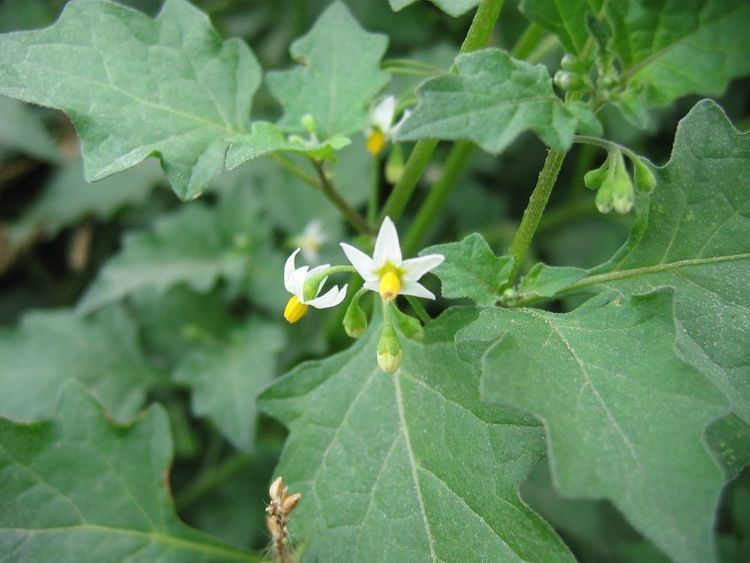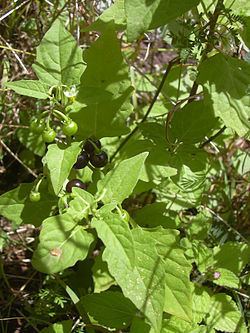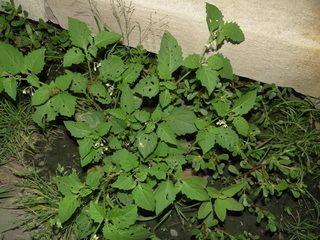Scientific name Solanum americanum Rank Species | Genus Solanum Higher classification Solanum | |
 | ||
Similar Solanum, Nightshade, Black nightshade, Solanum ptychanthum, Solanum villosum | ||
Plant identification nightshade solanum americanum
Solanum americanum, commonly known as American black nightshade, small-flowered nightshade or glossy nightshade is a herbaceous flowering plant of wide though uncertain native range. The certain native range encompasses the tropics and subtropics of the Americas, Melanesia, New Guinea, and Australia.
Contents
- Plant identification nightshade solanum americanum
- Description
- Taxonomy
- Toxicity
- Food
- Medicine
- Medical Research
- References

The plant is widely naturalised around the Tropical Pacific and Indian Oceans, including Hawaiʻi, Indochina, Madagascar and Africa, possibly via anthropogenic introduction in these locales.
Solanum americanum is one of the most widespread and morphologically variable species belonging to the section Solanum. It can be confused with other black nightshade species in the Solanum nigrum complex.

Description

Solanum americanum grows up to 1–1.5 metres (39–59 in) tall and is an annual or short-lived perennial. The leaves are alternate on the branch, and vary greatly in size, up to 10 centimetres (3.9 in) long and 7 centimetres (2.8 in) broad, with a 4-centimetre (1.6 in) petiole and a coarsely wavy or toothed margin. The flowers are about 1 cm diameter, white or occasionally light purple, with yellow stamens. The fruit is a shiny black berry 5–10 millimetres (0.20–0.39 in) diameter, containing numerous small seeds.
Taxonomy

Solanum americanum is a variable taxon. It is considered by some botanists to be more than one species, and others recognise subspecies. Some botanists have suggested that Solanum americanum may be conspecific with the European nightshade, S. nigrum.
Toxicity

Research indicates the presence of toxic glycoalkaloids and there are warnings to be careful on the use of S.americanum as herbal medicine and food. The green fruit is particularly poisonous and eating unripe berries has caused the death of children. Ripe berries and foliage may also cause poisoning. This is via high levels of the glycoalkaloids, solanine and solamargine,. Other toxins present in the plant include chaconine, solasonine, solanigrine, gitogenin and traces of saponins, as well as the tropane alkaloids scopolamine (hyoscine), atropine and hyoscyamine.

Significant amounts of solasodine(0.65%) have been found in the green berries. The ripe fruit also contains 0.3-0.45% solasonine, and acetylcholine, and has a cholinesterase-inhibiting effect on human plasma. In Transkei, rural people have a high incidence of esophageal cancer thought to be a result of using S.americanum as a food. Livestock can also be poisoned by high nitrate levels in the leaves.
Toxicity varies widely depending on the genetic strain and the location conditions, like soil and rainfall. Poisonous plant experts advise: "...unless you are certain that the berries are from an edible strain, leave them alone."
Food
The ripe fruit is cooked into jams and preserves, or eaten raw. In Africa, South America, New Guinea and Oceania the young green shoots of Solanum americanum are cooked and eaten as greens, after boiling in water. The cooking water used for boiling the leaves is discarded as it contains the soluble alkaloids. In Kenya, Cameroon and Papua New Guinea the leaves are sold as a leaf vegetable in the markets. The leaves are used in a West Indian stew, and it is known as branched Kalaloo. In Mauritius it is cultivated and eaten as a pot-herb and used in bouillon. Experts warn that care should be taken since numerous toxins are reported with levels varying with local conditions and varieties.
Medicine
It is used as a medicine in Cameroon, Kenya, Hawaiʻi, Panama, Sierra Leone, Tanzania and Pakistan. In China a tea from the whole plant is used to treat cancer of the cervix. It is used as folk medicine for a wide range of conditions, being applied topically and internally.
Medical Research
Extracts from S. americanum were found to have selective antiviral activity against the herpes simplex type-1 virus (HSV-1).
Methanol extracts of S.americanum have high antimicrobial activity against Escherichia coli, Pseudomonas aeruginosa, Staphylococcus aureus and Aspergillus niger. Water based extracts had no antibacterial activity.
